Purchase orders (POs) play a vital role in every organization, whether it’s a university ordering library books, a company procuring raw materials for manufacturing, or an agency purchasing services from a vendor.
POs are also one of the most admin-heavy business processes. They’re prone to errors, bottlenecks, lost paperwork, unnecessary back and forth, and maverick purchases.
This can lead to incorrect goods or service delivery, delayed orders, overspending, and even outright fraud, if Purchase Order tracking systems are not in place.
According to The Hackett Group, most organizations can reduce their operational costs by as much as 45% by implementing digital procurement tools for smart data capture and workflow automation.
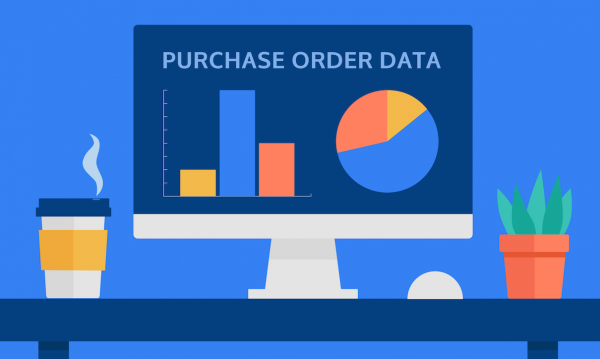
Contents
- What Is Purchase Order Tracking?
- How to Track Purchase Orders Efficiently
- Advantages of Purchase Order Tracking
- Set Up Automated Purchase Order Tracking in 3 Steps with frevvo
What Is Purchase Order Tracking?
Purchase order tracking helps organizations make their procurement processes much more efficient and transparent. With PO workflow automation, organizations can create digital purchase orders and swiftly route them for approval. It also makes it easy to keep track of each purchase order as it passes through multiple stages and various parties.
The ability to easily track POs is one of the key benefits of purchase order workflow automation software. Purchase order tracking refers to the act of monitoring the status of purchase orders, either in real-time or in an analytics dashboard – or both.
How to Track Purchase Orders Efficiently
Typically, to find out the status of a PO, employees or departments need to retrieve the PO number and phone or email the procurement department or even the vendor. If they’re lucky, the person they’re asking for an update is organized and has the information on-hand to provide an answer immediately. However, this is rarely the case in paper-heavy offices, which means waiting for an update.
With PO automation, tracking is efficient and painless. Anyone in the workflow can check the current status of the PO – as well as vendor information, order date, and more – with a couple of clicks. Meanwhile, automated notifications help to keep everyone updated as the PO moves from step to step.
Moreover, by integrating your purchase order tracking software with your accounting software or creating a custom dashboard, you can get detailed insights into your spending.
Advantages of Purchase Order Tracking
Manual PO processing involves an endless stream of Excel sheets, email back-and-forth, lost papers, and late invoice payments – not to mention invoicing fraud going undetected.
With digital transformation and operational efficiency on everyone’s lips, there’s no better place to start than procurement and accounts payable. Purchase order tracking offers many advantages over the traditional, outdated way of doing things.
Here are a few:
Increased Convenience and Quicker Processing
With automatically tracked POs, you can say goodbye to countless hours of tedious administrative tasks and approval bottlenecks. Save time by creating digital purchase orders and automating routing between approving parties.
Automated notifications and reminders help to keep things moving so that POs don’t lie forgotten in inboxes, and make it easy to keep track of which stage the purchase order is currently in.
Greater Control Over Expenditure
Building conditional routing into your purchase order workflow helps make sure that POs are subject to approvals under specific conditions. For instance, if purchase orders exceed a predetermined amount or originate from a department with a history of overspending, it automatically routes to a senior manager for approval. This helps to ensure that your organization’s procurement policies are followed.
Fewer Errors, Inconsistencies, and Fraud
Automation drastically reduces errors and vulnerability to fraud by taking manual data entry out of the equation, standardizing approvals, and enabling automatic matching.
It’s easy to connect your workflow with other business tools such as your SQL database, Google apps, or accounting software. This means you can create dynamic forms that automatically populate forms with known information such as employee details. You can sync in both directions, making it easier to update your records in your database using data from your workflow submissions. You can also set up automatic matching between invoices and purchase orders to flag inconsistencies for review, reducing the likelihood of invoicing fraud.
Automated workflow tracking creates a robust audit trail and builds approvals into the PO process, which means maverick purchases and outright fraud is much easier to detect and prevent.
Standardized, Consistently Compliant Forms
Purchase order tracking software allows you to standardize your forms and workflows, which reduces deviations from your company policy.
Using standardized PO forms across suppliers can also take a few minutes out of the process as employees won’t need to locate each supplier’s form before creating a PO.
By standardizing your forms, you can ensure that they are always compliant with internal policies and vendor requirements as well as government regulations.
Reduced Operational Costs
Tracking purchase orders digitally can save your organization time, money, and resources by removing much of the manual work out of the purchase order process. By freeing up your employees’ time, PO automation allows them to be more productive and focus on what you hired them to do instead of mind-numbing admin.
Greater Transparency and Spending Insight
Accurate PO tracking gives you far greater insight into how efficiently you’re spending money as a business. Reviewing and analyzing your spending patterns can lead to considerable savings. PO automation software often comes with built-in dashboards that update in real time. When you can see all your accounts payable expenditures at a glance, it’s easier to trim the fat.
When you can quickly find out which departments are overspending, which recurring expenses can be reduced, and which vendors are ripping you off, you can take action to curb excessive spending, such as refining your procurement policies.
Optimized Business Intelligence
Purchase order tracking also drives business intelligence and can give greater visibility into the status of specific projects. For example, seeing that a key supplier has delivered your materials early might allow you to adjust your manufacturing timeline.
Or, you might set automated deadlines by which date orders must have been shipped to allow you to source form alternative vendors to prevent delays and ensure that your product launch stays on track.
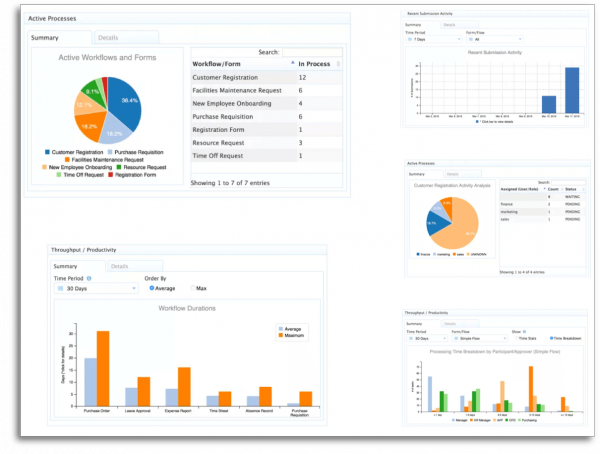
Dashboards let you view your procurement workflow analytics.
Set Up Automated Purchase Order Tracking in 3 Steps with frevvo
Every organization’s approach to the procurement process is unique. As such, each business needs a slightly different solution when it comes to automating purchase order tracking.
With frevvo, you can automate many of your accounting processes and create a purchase order workflow that meets your exact needs. Use our drag-and-drop visual form builder and workflow designer to create the perfect custom digital PO form for your business and set up approval routing rules – all without any coding knowledge or help from I.T.
Say goodbye to error-prone Excel spreadsheets, rote data entry, and manual approval processes that cause delays, costly mistakes, and missed purchases that impact roadmaps.
Automating your purchase order workflow and tracking POs digitally is easier than you think. Simply follow the steps below and you’ll be reaping the benefits in no time.
Note: The following steps require a frevvo account. You can sign up for a free 30-day trial.
Step One: Install a Template
Hit the ground running. Install a pre-built purchase order form template with a single click.
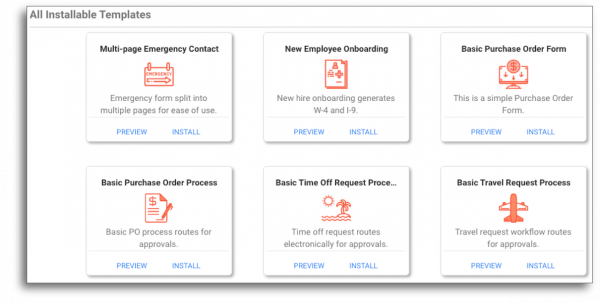
Step Two: Customize Your Purchase Order Form
Modify the template to build the exact form you need without any coding using our 100% visual form builder. Should you need assistance, we offer no-obligation support options to help you out.
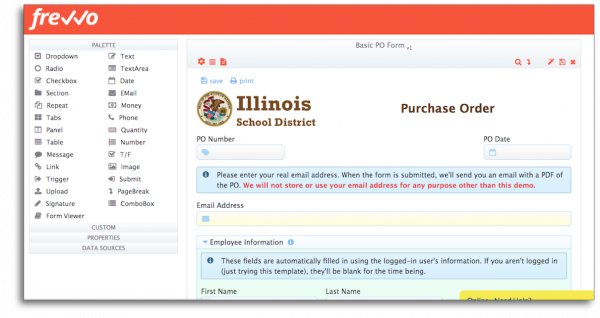
Step Three: Configure Conditional PO Routing
Next, set up your workflow using the drag-and-drop workflow designer. You can also simply select the purchase order workflow template and customize it in accordance with your organization’s needs and policies.
Establish conditional routing rules to make sure POs are routed to the relevant parties for high-level approval when certain conditions are met. For instance, an order exceeding a set amount or a budget milestone being hit may trigger additional routing before the PO is processed by the accounts payable department.
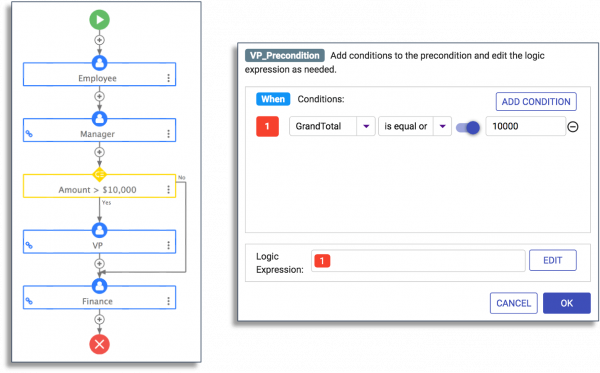
Deploy and Track Purchase Orders Automatically
After testing the workflow, deploy it with a single click. To track your purchase order, simply go to your task list and view the built-in audit trail for the PO. You can search for specific POs using data in the form and view the current status at any time.

frevvo comes equipped with a number of built-in workflow analysis reports. Using these reports, it’s easy to track purchase orders, identify bottlenecks, and optimize operational efficiency.
For example, you can easily track all currently open purchase orders by viewing the Active Processes report and drilling down to the purchase order process.
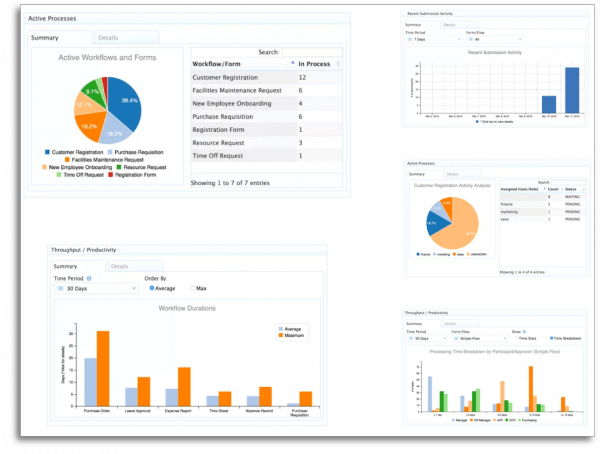
For a detailed overview of workflow analysis and how to use frevvo’s built-in reports to improve productivity, read Workflow Analysis: How to Improve & Optimize Your Processes.
Want to automate your purchase order tracking?
frevvo makes it easy to automate and track purchase order workflows. Try it free for 30 days.




